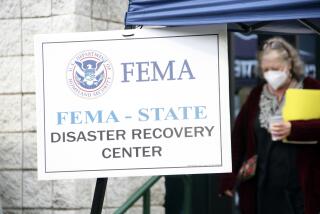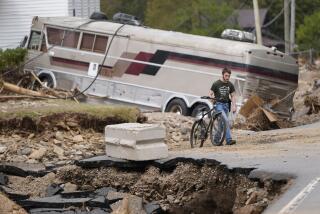Bertha Threatens Carolinas, Kicks Up Wave of Evacuees
- Share via
SOUTHPORT, N.C. — Tens of thousands of people, many of them tourists, fled inland Thursday as the hungry wind of Hurricane Bertha howled across the Outer Banks and threatened to devour the Carolina coast.
The governors of North and South Carolina declared emergencies in 36 counties, giving state officials authority to enforce evacuation orders, call out the National Guard and remove any local officials who refused to cooperate. Restaurants closed. So did stores. Beach cottages emptied, and so did campgrounds.
At midnight EDT, Bertha was about 220 miles south of Wilmington, N.C., and churning northwest at 10 mph. It packed sustained winds of 80 mph, down from 105 mph earlier in the day. The National Hurricane Center in Miami said the eye of the storm would cross land between Charleston, S.C., and Myrtle Beach, S.C., at about noon today.
In its path northwest from the Caribbean, Bertha has left seven dead: one in Florida and the other six in Puerto Rico, the U.S. Virgin Islands and St. Martin. In addition, a 4-year-old boy, Sean Cannon, was killed and his mother, Robin, 31, was hurt in the crash of an Air Force F-16 jet fighter being evacuated to avoid the hurricane.
The plane, flying from Shaw Air Force Base, S.C., to Eglin Air Force Base, Fla., experienced engine failure Thursday about 20 miles north of Pensacola, Fla. It crashed into the child’s home and scattered wreckage throughout the neighborhood. The pilot, Capt. Frederick G. Hartwig, 35, ejected safely into a tree, but the house burned.
Although Bertha was losing punch, said Jerry Jarrell, deputy director of the National Hurricane Center, “this is a huge hurricane, so it’s going to create a strong surge and large waves. It can do real damage.” He said winds of hurricane force--74 mph at minimum--extended 115 miles east of the eye of the storm.
“The whole storm,” Jarrell said, “is the size of Georgia.”
Bertha will linger over land, he predicted, then lose strength and turn into a nor’easter. With rainfall expected to climb to 8 inches, Jarrell warned, “[Bertha’s] real threat may be as a rainmaker over the mountains” when the remnants of the hurricane push inland. “Rain in the mountains,” he said, “could be a killer.”
As winds with the force of a tropical storm reached the Outer Banks, residents and vacationers alike fled Myrtle Beach in lines of cars and trucks that stretched for miles along the roadways. By evening, there was no traffic at all on Ocean Boulevard, usually teeming with tourists.
The financial impact was sizable: Along the length of South Carolina beaches, called the Grand Strand, an estimated 175,000 vacationers spend more than $14 million a day each summer, state parks spokesman Lou Fontana told the Associated Press.
Other tourists and residents by the thousands fled along a honeycomb of highways in North Carolina that stitch the city of Wilmington, population 55,000, to seaside communities stretching from Calabash north to Wrightsville Beach.
Many businesses in Wilmington took no chances. With the first gusts of wind, employees taped the windows at a Circuit City store and a nearby restaurant called Mr. Chopstix.
Officials in the coastal communities ordered more than 100,000 people to leave for higher ground. At the town of Southport, across a bay from Cape Fear, residents carefully taped their windows before abandoning scores of homes and house trailers.
Although Southport declared a 9 p.m. curfew, no one at the Harbor Light, a cinder block saloon with a bar, a jukebox and a pool table, paid much attention. “Business is a little off,” said Mark St. Ana, the owner. “Some folks took off or are staying in, but we’ll probably stay open until 11:30 or midnight.”
St. Ana planned to spend the night in his establishment, after his patrons left. He knew there was not much he could do if things got nasty. “Some of us are fearless,” he declared. “The rest of us are stupid.”
John McIlvaine, working on his third beer, which sold for $4 a pitcher, had taken modest precautions. He had moved his car to the Food Lion market, for instance, hardly high ground--but the highest around.
“Southport is going to get hit,” McIlvaine said, proudly. “It’s going to hit us smack-on.”
Over at the town of Boiling Springs, Steve Larson, a captain in the volunteer Fire Department, was stationed with his pumper and crew at the Old Brunswick gas stop and grill. “We spread the five trucks around in case we’re needed,” Larson said. “You don’t want to drive 20 miles to help somebody out.”
One of his recruits, Justin McLeod, said the surrounding pine trees were not likely to rip out of the ground during the hurricane because their roots were so deep. “They’re more likely,” he said, with small comfort, “to snap in half.”
In a new townhouse development near Orton, Charles LaGrue stood shirtless in the muggy evening air. With one hand, he held a long-necked bottle of beer. “I’m staying,” he declared boldly. “We laid in some supplies.”
He glanced at his drink. “I’m not too worried.”
Preservationists, however, were concerned about what the storm would do to North Carolina’s oldest lighthouse, on Bald Head Island near Cape Fear, at the mouth of the Cape Fear River.
The lighthouse, called Old Baldy, has guided boat pilots for more than 150 years as they neared the ocean. Restored and relighted in 1988 after 20 years of darkness, Old Baldy has weathered three wars, countless storms and many years of neglect.
Worry spread from the coastal region to cities and towns far inland. “Bertha is a very large hurricane that will impact a tremendous area,” Gov. James B. Hunt Jr. said in a televised warning to everyone in North Carolina. “It looks like it’s coming straight at us.”
The area of impact was expected to be so large that Gov. David Beasley activated two National Guard military police units in South Carolina to help state and local police handle evacuations and discourage any looting.
In addition to the jet from Shaw Air Force Base, the military ordered its aircraft to be evacuated from airfields scattered throughout the east, from Pennsylvania to the Florida Panhandle. The Navy ordered its ships to put to sea to avoid damage from docks and other stationary objects.
In Savannah, Ga., officials at the Olympic yachting venue kept their boats out of the water for a second day. Amtrak canceled or curtailed southbound train service along its East Coast tracks.
As the storm moved north, forecasters anticipated a letdown, especially among those farther south who heeded evacuation orders for nothing. “We will probably burn some credibility on this one,” said Jarrell, the National Hurricane Center deputy director. “But when the warnings go up, governors have to respond.”
Many of those feeling the letdown were in Florida, where evacuation orders were lifted earlier in the day.
A half-million people had been urged to leave six coastal counties. One among the many who did not evacuate was killed. He was William Russell Hughson, 28, of Indianapolis. Hughson was in Florida visiting relatives. Hurricane swells carried him out to sea.
Hughson’s 16-year-old brother was rescued.
Of the six additional deaths blamed directly on Bertha, three were in Puerto Rico, one was in the U.S. Virgin Islands and one was in St. Martin. The sixth was a passenger who fell from a boat off the St. Martin coast. Another boat with 42 people aboard still was reported missing off Puerto Rico.
Many institutions in Florida had taken the evacuation orders seriously. Officials emptied hospitals and nursing homes and took their patients into shelters.
Thousands of motorists had jammed gasoline stations and tanked up to drive inland. Most drove west and south, away from Bertha’s predicted path of peril. They came back happily.
At Daytona Beach, Fla., Anna Garifola, 74, returned to her home after spending a night inland with one of her daughters.
“When they said evacuate, I left,” she told the AP. “I took my birds and went.”
But returning did not mean an end to her worry. Garifola has another daughter. She lives in North Carolina.
Bornemeier, a Times staff writer, reported from Southport; Clary, a Times special correspondent, reported from Miami. Researcher Edith Stanley in Atlanta and staff writers Mark Lacey in Virginia Beach, Va., and Richard E. Meyer in Los Angeles also contributed to this story.
More to Read
Sign up for Essential California
The most important California stories and recommendations in your inbox every morning.
You may occasionally receive promotional content from the Los Angeles Times.













